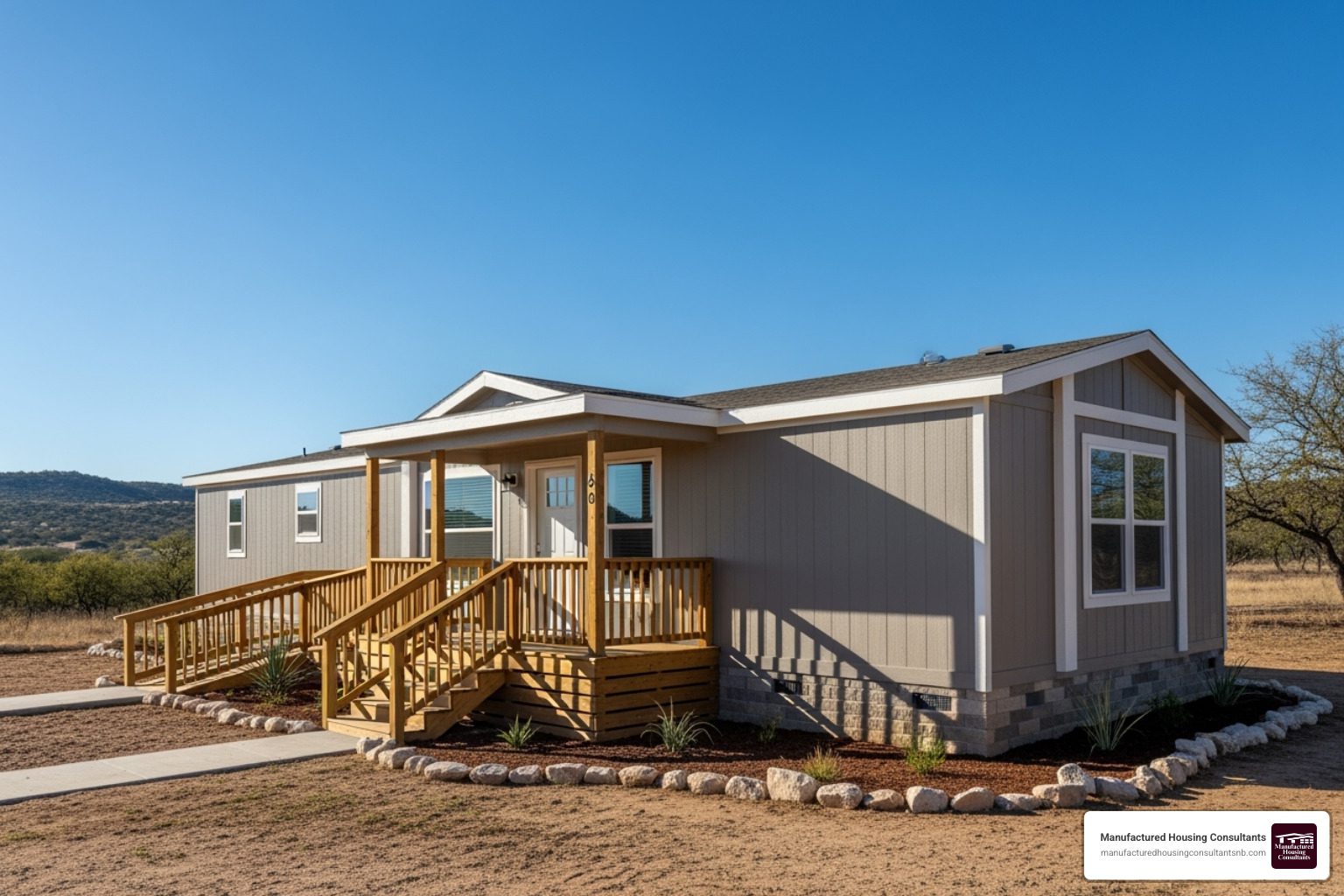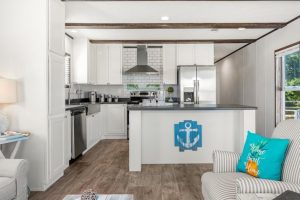Ramp Up Your Mobile Home: Essential Porch Designs
Design your ideal mobile home porch with ramp for accessibility, value & safety. Learn planning, materials & Texas codes.
Why Accessibility Matters for Your Manufactured Home
A mobile home porch with ramp transforms your manufactured home into an accessible, safer, and more valuable property. Whether for aging in place, accommodating mobility challenges, or simply improving functionality, the right design is key.
Quick Answer: Key Considerations for Mobile Home Porch Ramps
- Slope: Follow the 1:12 ratio (1 inch of rise per 12 inches of length)
- Width: Minimum 36 inches for wheelchair access
- Materials: Pressure-treated wood, composite decking, or aluminum
- Handrails: Required for ramps longer than 6 feet
- Permits: Check local New Braunfels building codes before starting
- Foundation: Use independent, self-supporting footings for stability
Mobile homes are affordable for Texas families but often lack accessible entries. While ramps can be a significant investment, the investment pays off through improved quality of life, increased home value, and broader buyer appeal.
At Manufactured Housing Consultants in New Braunfels, we believe accessibility is essential. We help Texas homeowners design stylish, safe porches and ramps that meet local codes and improve curb appeal.
Adding a ramp is achievable for new or existing homes. With proper planning, Texas-appropriate materials, and adherence to safety standards, you can create a lasting, functional outdoor space.

Planning Your Mobile Home Porch with Ramp
Proper planning is the first step to ensuring your mobile home porch with ramp is safe, functional, and adds value to your Texas home. Let’s walk through the key decisions.
Key Benefits: Accessibility, Value, and Lifestyle
A well-designed ramp offers more than just simple access; it improves your lifestyle.
- Independence and Quality of Life: For those with mobility challenges, including seniors aging in place, a ramp provides the freedom to come and go without assistance. It removes barriers, reduces stress, and allows everyone to enjoy their home and outdoor space fully.
- Increased Home Value and Appeal: A quality ramp makes your property more marketable to a wider range of buyers, including families with elderly relatives or members with disabilities. This accessibility feature is a significant advantage that can increase your home’s resale value.
- Safety and Convenience for Everyone: Ramps are safer than stairs, reducing fall risks for the whole family. They also make everyday tasks easier, from carrying groceries and moving furniture to pushing strollers or garden carts.

Choosing the Right Ramp Type for Your Home
Choosing the right ramp depends on your budget, long-term needs, and property layout.
- Permanent Ramps: Built into your home’s structure from materials like pressure-treated wood or concrete, these offer maximum durability and a seamless look. They have the highest weight capacity (1,000-1,200 lbs) but require a larger investment, permits, and are not flexible.
- Modular Ramps: Made from aluminum sections, these are adaptable and can be configured as straight, L-shaped, or switchback ramps to fit your space. They are durable, low-maintenance, and can be moved or reconfigured if needed. Installation is faster than permanent ramps, and they support 800-1,000 lbs.
- Portable Ramps: These lightweight, foldable aluminum or rubber ramps are a budget-friendly solution for temporary needs or small thresholds. They require no installation but are not suitable for high elevations and have a lower weight capacity (600-800 lbs).
Your property’s layout will determine the best configuration. A straight ramp is most direct, while an L-shaped ramp or switchback ramp with landings conserves space on properties with limited room or higher porches.
Critical Design Elements: Slope, Width, and Landings
Getting the design right is crucial for safety and usability. Adhering to ADA guidelines is the best practice for residential ramps.
- Slope Ratio: The most critical element is the 1:12 slope ratio. This means for every 1 inch of vertical rise, you need 12 inches (1 foot) of ramp length. For a porch 30 inches high, you need a 30-foot long ramp. This gentle incline is essential for safe navigation, especially for manual wheelchair users.
- Width: A 36-inch minimum width between handrails provides comfortable passage for wheelchairs and walkers. Wider is often better if space permits.
- Landings: For long ramps, flat landing platforms are essential resting points. The ADA recommends a 5×5 foot landing for every 30 inches of vertical rise. Level landings are also required at the top and bottom of the ramp. The top landing must be flush with the door threshold to eliminate tripping hazards and ensure a smooth threshold transition.
You can learn more about these standards at ADA ramp guidelines, and our team at Manufactured Housing Consultants can help you apply them to your specific New Braunfels property.

Building Your Ramp: Materials, Codes, and Safety
With a solid plan, it’s time to focus on construction. This involves selecting materials for the Texas climate, understanding New Braunfels building codes, and incorporating essential safety features.
Best Materials for Durability and Aesthetics
Choosing the right material involves balancing durability, maintenance, cost, and aesthetics, especially for the Texas climate.
- Pressure-Treated Wood: An affordable, classic option that can be stained to match your home. It resists rot and insects but requires regular sealing to prevent warping and splintering. Always use galvanized screws for a secure, rust-free hold.
- Composite Decking: A low-maintenance blend of wood fibers and plastic that resists fading, staining, and rot. Many options have built-in slip resistance, a key safety feature. The upfront cost is higher than wood but is offset by long-term maintenance savings.
- Aluminum: The standard for modular systems, aluminum is lightweight, rust-proof, and extremely durable. Many feature an open-mesh design for natural slip resistance by allowing water to pass through. It requires almost no maintenance.
- Concrete: The most permanent and durable option, concrete is fire-resistant and can be finished with stamps or stains. However, it’s the least flexible option and requires professional installation.
Do not use plywood or MDF for outdoor ramps, as they will quickly rot and fail in Texas weather.
| Material | Cost (Relative) | Durability in Texas Weather | Maintenance | Aesthetics | Notes |
|---|---|---|---|---|---|
| Pressure-Treated Wood | Low-Medium | Good | Regular sealing | Natural, customizable | Use screws, not nails. |
| Composite Decking | Medium-High | Excellent | Low (cleaning) | Modern, many colors | Resists rot, insects, fading. Slip-resistant. |
| Aluminum | High | Excellent | Very Low (cleaning) | Modern, industrial | Rust-proof, lightweight. Open mesh is common. |
| Concrete | Medium | Excellent | Low (cleaning) | Permanent, can be styled | Requires professional installation. |
For inspiration, you can view inspiring porch designs to see how these materials look.
Navigating Texas Building Codes and Permits for a mobile home porch with ramp
Building a mobile home porch with ramp in New Braunfels requires adherence to local building codes and permits. These regulations exist to ensure your safety and protect your investment.
Always contact your local building department to get specific requirements for ramp slope, width, handrails, and structure. Most permanent ramps require a building permit. A permit ensures your ramp is inspected for safety, which is often required for insurance coverage and adds credibility when selling your home.
A critical rule for manufactured homes is that your porch and ramp must be self-supporting. It cannot be attached to or rely on the mobile home’s frame or foundation. The structure must have its own independent footings (like concrete piers) set separately from the home’s foundation. This prevents shifting from damaging either the home or the ramp and is often a condition of the home’s warranty.

At Manufactured Housing Consultants, we guide New Braunfels area homeowners through these local requirements to ensure every project is compliant and built to last.
Essential Safety Features for Your mobile home porch with ramp
A safe mobile home porch with ramp includes several non-negotiable features to protect everyone who uses it.
- Handrails and Guardrails: Ramps longer than six feet or rising more than six inches need continuous handrails on both sides. If the ramp is over 30 inches high, guardrails are required to prevent falls.
- Non-Slip Surfaces: Essential for Texas weather. Choose composite or aluminum with built-in texture, or apply grip tape or non-slip paint to wooden ramps. Open-mesh aluminum is excellent for letting rain pass through.
- Adequate Lighting: Use motion-sensor or solar lights to illuminate the entire ramp, landings, and handrails for safe nighttime use.
- Smooth Transitions: The points where the ramp meets the porch and the ground must be perfectly level and free of gaps or lips to prevent trips or stop wheelchair wheels.
- Regular Maintenance: Periodically inspect your ramp for loose fasteners, splinters, or wear. Keep it clear of leaves and debris to prevent slip hazards.

Conclusion
A mobile home porch with ramp is a transformative addition, offering independence, safety, and improved property value. By following key design principles like the 1:12 slope, choosing durable materials for the Texas climate, and adhering to local New Braunfels building codes, you can create a functional and attractive feature for your home.
A ramp doesn’t have to detract from your home’s curb appeal. With thoughtful design, materials like wood, composite, or aluminum can create a welcoming and stylish entryway for everyone.
At Manufactured Housing Consultants, we help Texas families find affordable housing solutions that fit their needs. We understand that accessibility is a necessity, not a luxury. Our team can help you customize a new home with accessible features or plan modifications for your current one. We know the local codes and can guide you to a solution that fits your budget.
If you’re ready to find a manufactured home designed for accessibility, we’re here to help.
Explore our mobile homes with porches today!
Your accessible dream home is waiting, and we’re here to make it a reality.


